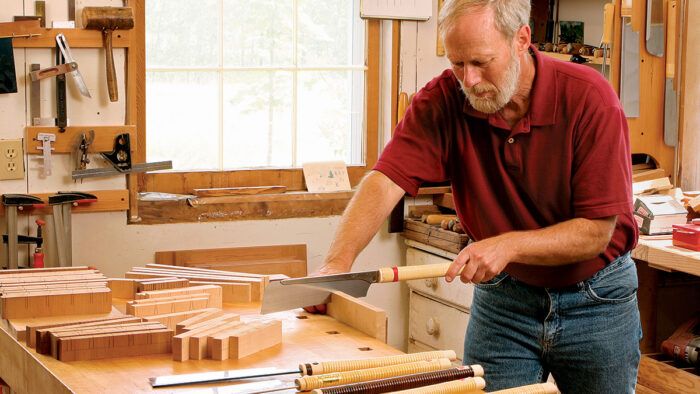Japanese-Style Dovetail Saws
Fast-cutting Japanese saws are affordable and razor-sharp out of the box.

Synopsis: Charles Durfee tests and evaluates a range of Japanese-style dovetail saws, also known as dozukis. In the process, he examines the four types of tooth pattern available on these pullsaws–crosscut, Ikeda crosscut, rip, and modified rip. He tested how fast each saw could make a rip cut, how easy they were to use, how smooth they cut, and how narrow a sawkerf they created. He also provides hints for using a pullsaw, such as the proper way to hold it, starting a cut, correcting a cut, and choosing the right type of saw.
My first woodworking years were spent building traditional wooden boats with a small group of similarly wide-eyed enthusiasts. We would gather around the woodstove to warm our fingers, and invariably would talk about tools. Our handsaws were the typical carpenter’s variety: crosscut and rip, with an occasional backsaw. Sharpened as best we could, they cut pine and cedar adequately, struggled in oak and mahogany, and in general made sawing by hand an unwelcome chore.
Then one day a shop-mate came in holding a carefully wrapped, slender package. He pulled out a strange-looking saw with a thin blade and a long, straight handle. He explained that the blade was so thin because this type of saw cuts on the pull stroke, an action that keeps the thin blade from buckling. The narrow blade naturally creates a thin kerf or cut, which means it requires less effort to remove less wood, and it cuts faster.
Brands tested:
|
We tried the saw. It was like touching the pedal of a Jaguar after driving a Ford all your life. The saw raced through the cut, straight down the line. It was my first exposure to Japanese handsaws, and I’ve been a fan ever since.
Although I’ve now used Japanese saws for 30 years, I’ve never really studied them other than to read catalog descriptions or the occasional article. When I needed a new one, I looked through tool catalogs and tried to figure out the differences among the many offered. Other than price, they seemed very similar in appearance and description, so the chance to test and evaluate a range of these saws was a fine opportunity to learn more.
Quick tour of a Japanese saw
Like their Western counterparts, Japanese saws come in a range of styles depending on the type of cut to be made and whether speed or smoothness is more important. The type of saw I tested is known as a dozuki, which means “tenon shoulder” in Japanese. The standard dozuki is a crosscut saw, but rip dozukis are finding their way into the market and examples are included in this review.
A dozuki has a very thin blade—generally 11 to 12 thousandths of an inch, or half the thickness of a Western sawblade—supported by a back of folded-over steel or have blades that can be resharpened, but that costs about $30 and the saw must be returned to Japan, so you’d be without it for three to four months.
From Fine Woodworking #188
For the full article, download the PDF below:
Fine Woodworking Recommended Products

Lie-Nielsen No. 102 Low Angle Block Plane

Veritas Wheel Marking Gauge

Bahco 6-Inch Card Scraper








Log in or create an account to post a comment.
Sign up Log in